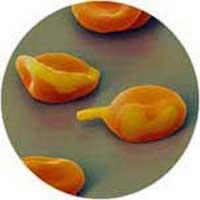Sweet success in the pursuit of bitterness
In 1944, American chemists Robert Woodward and William Doering almost managed to synthesize quinine, but were unable to control the appearance of the molecule and obtained a mixture of various variants of quinine. The atoms of the molecule of quinine can have a left or right configuration and find a direct combination between both variants is what makes its synthesis difficult.

The parasite of malaria within cells.
Now, as published on the web of the journal Nature, researchers at the University of Columbia have achieved a synthetic quinine. However, at present, the importance of this result is not equal to what it could have in its day, since from the decade of the 40 appeared other drugs like chloroquinine. In addition, quinine does not cure malaria, its effect is to stop the growth of the malaria parasite Plasmodium falcifarum.
However, since 1960 the parasite P. falcifarum has shown its resistance to chloroquine in some areas, where the use of quinine was resumed. Consequently, obtaining synthetic quinine can be the first step towards more efficient variables. Therefore, there seems to be progress in the fight against malaria.
Buletina
Bidali zure helbide elektronikoa eta jaso asteroko buletina zure sarrera-ontzian











